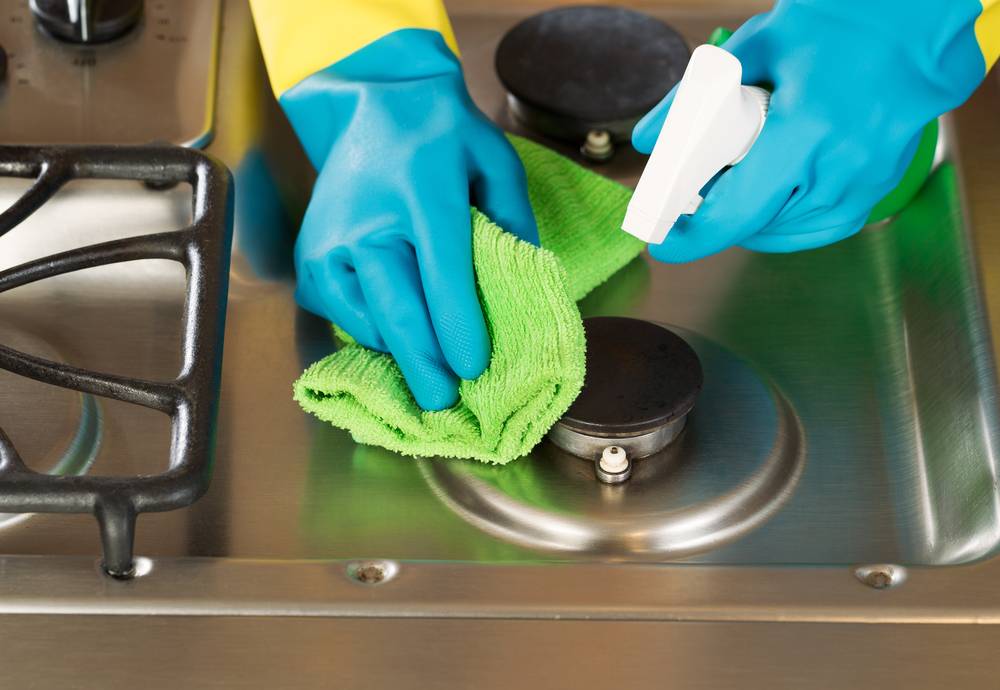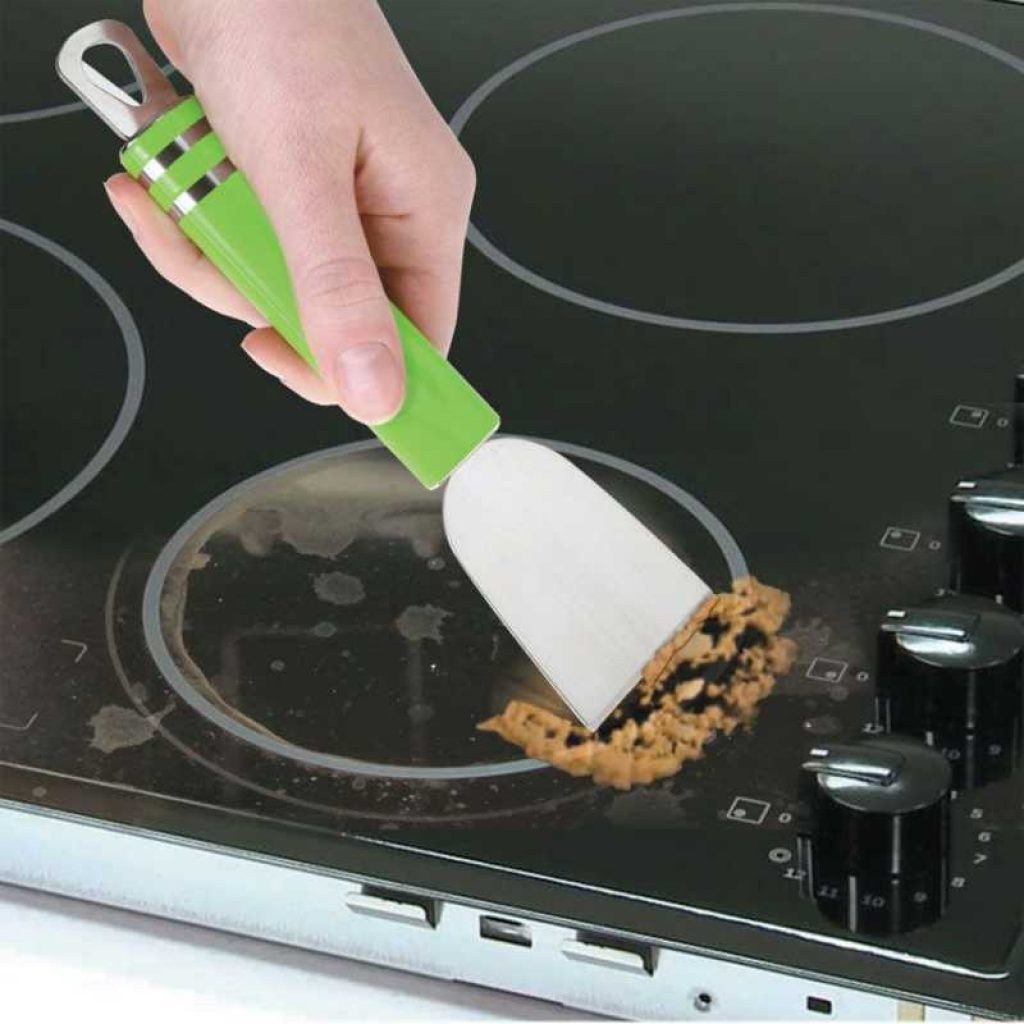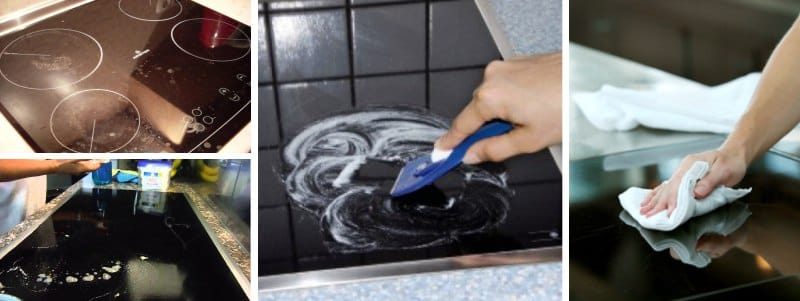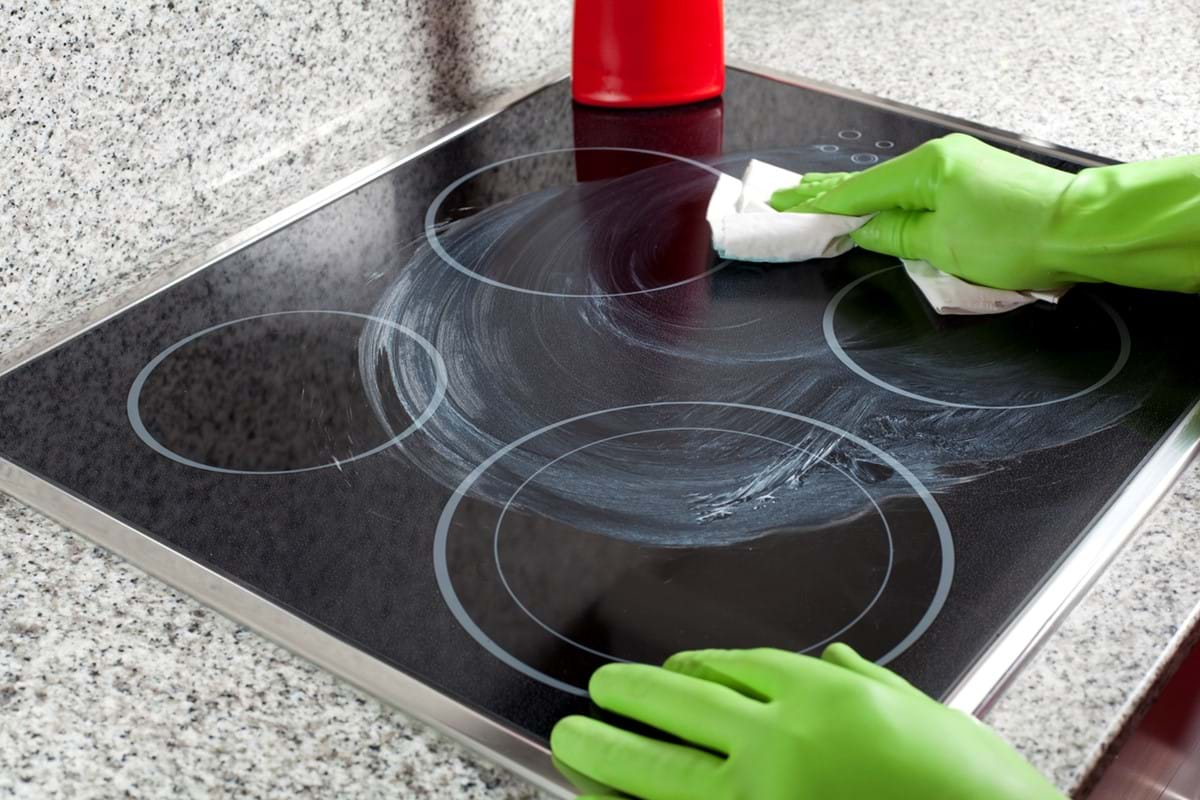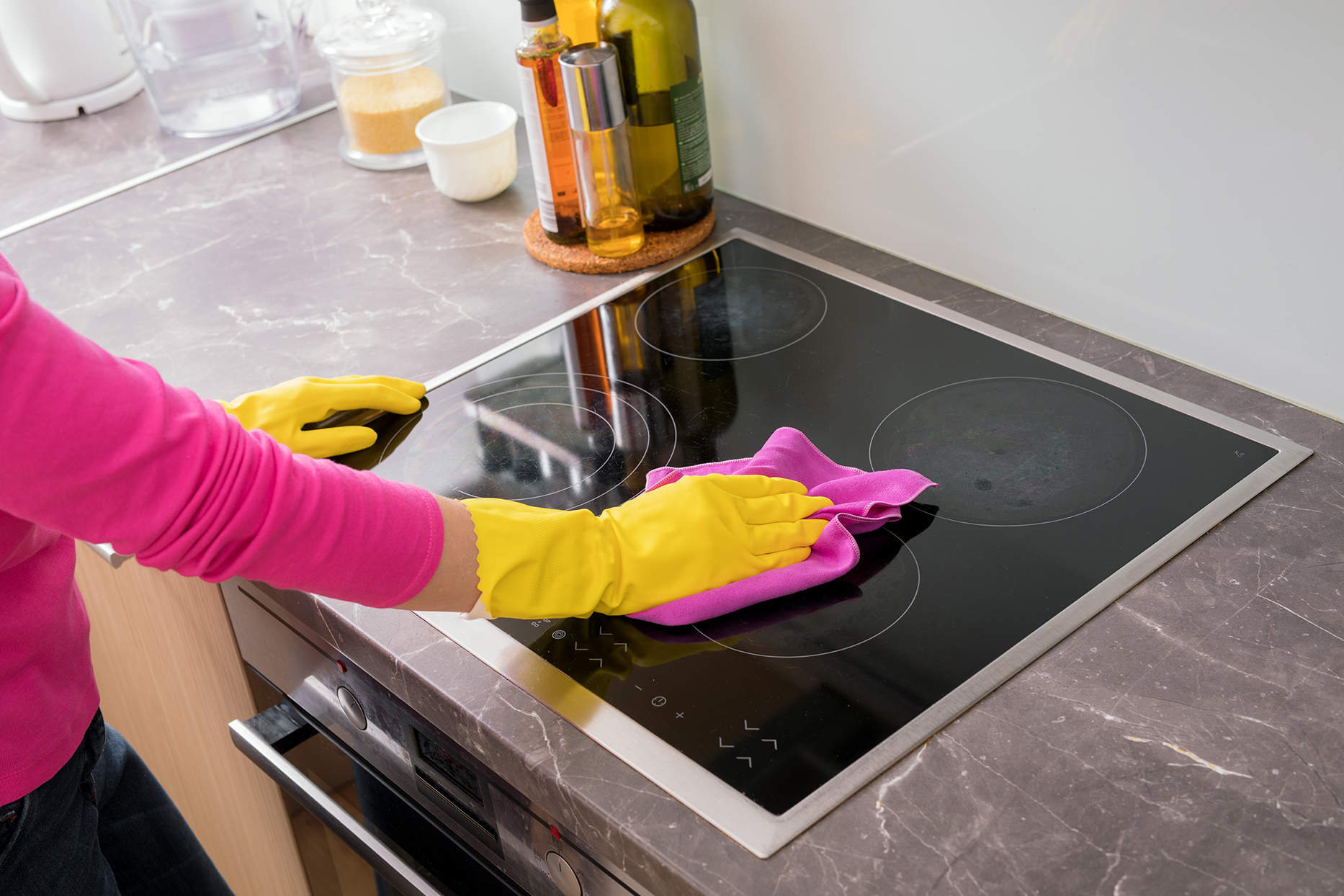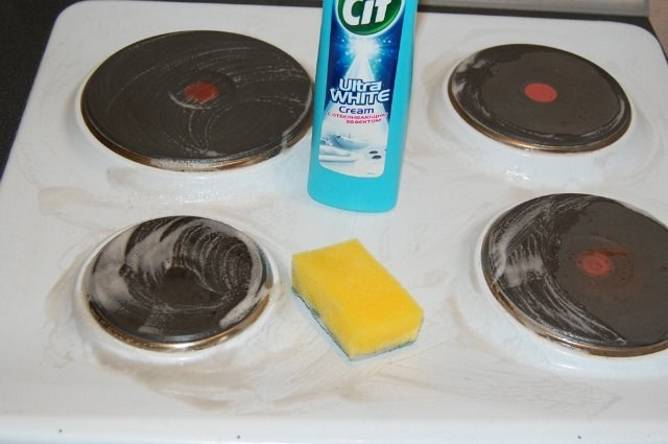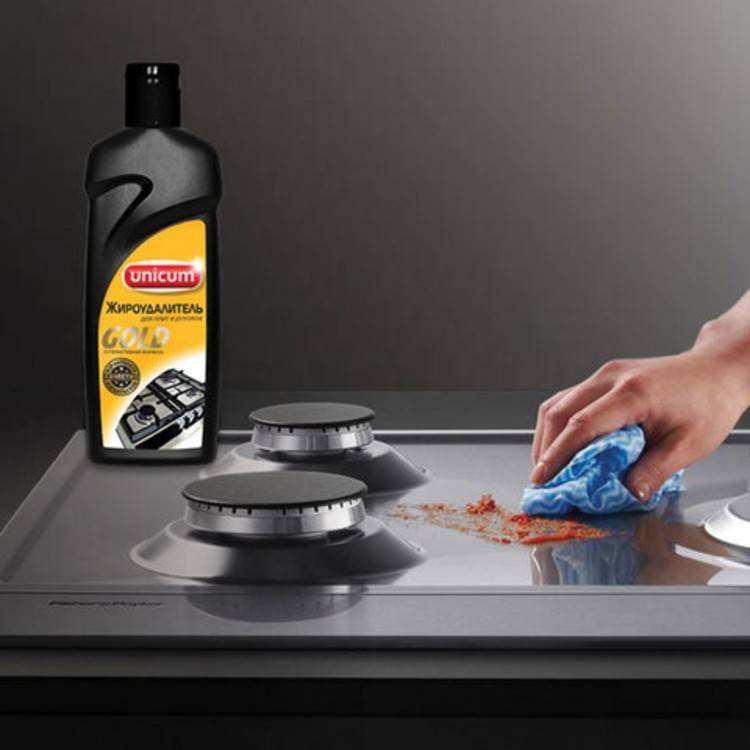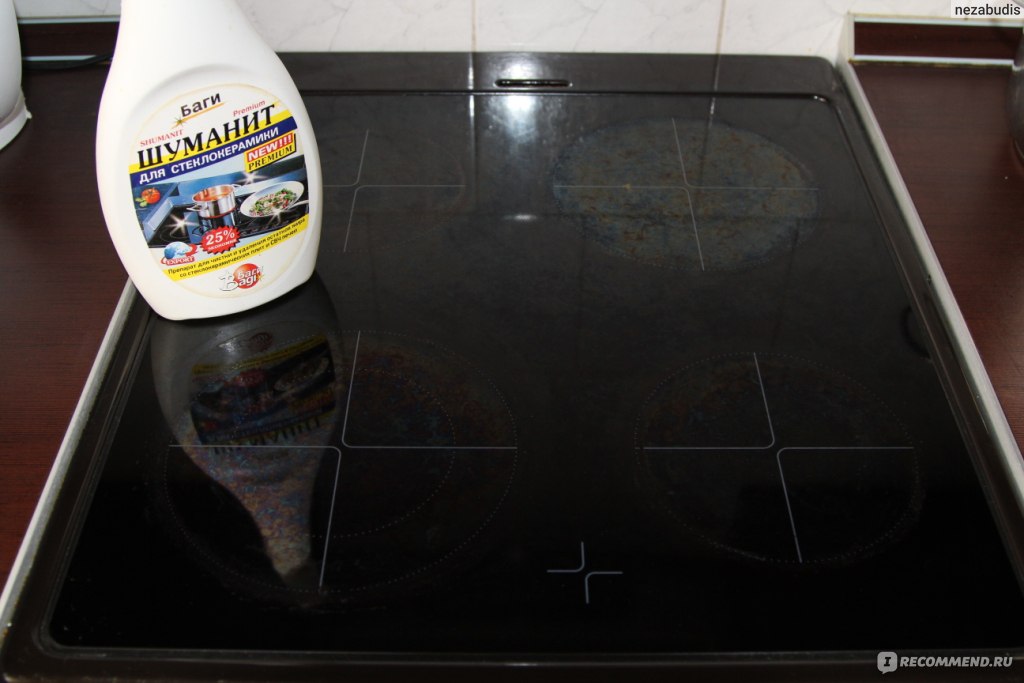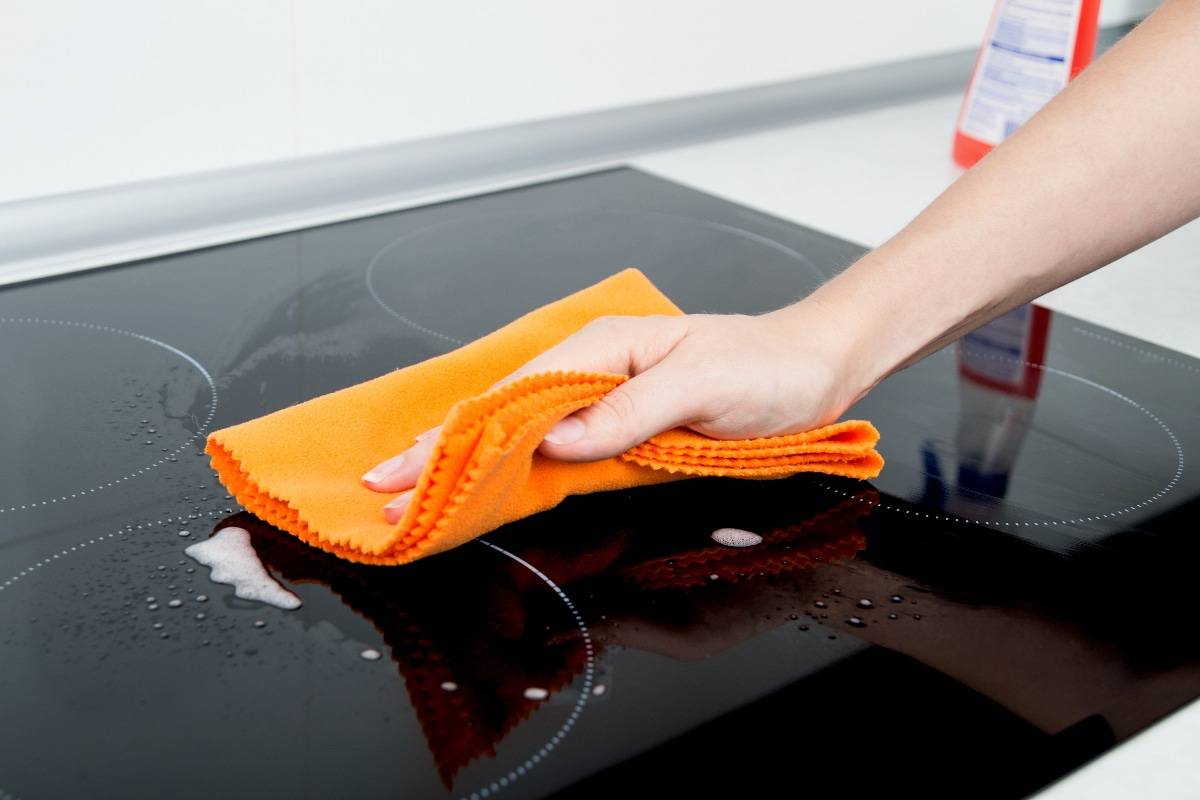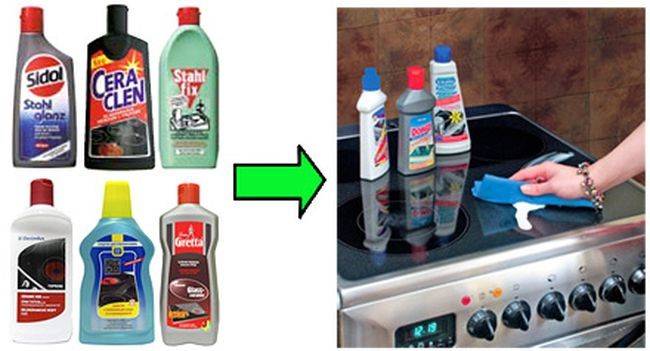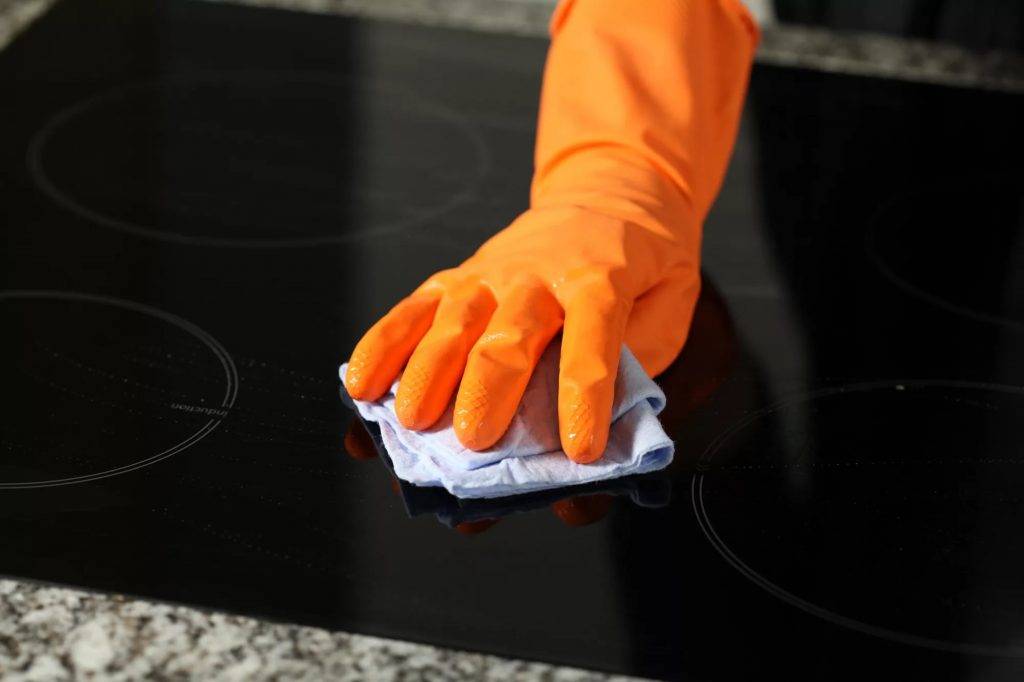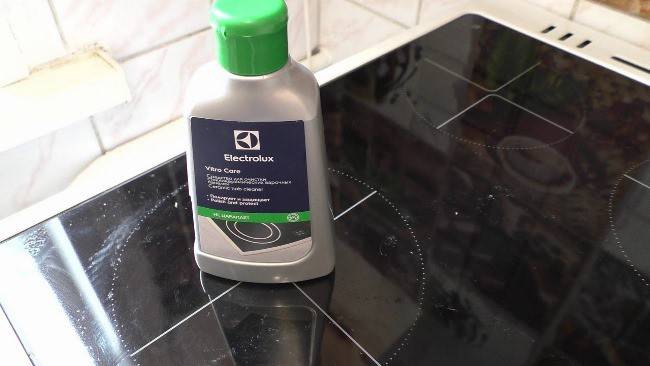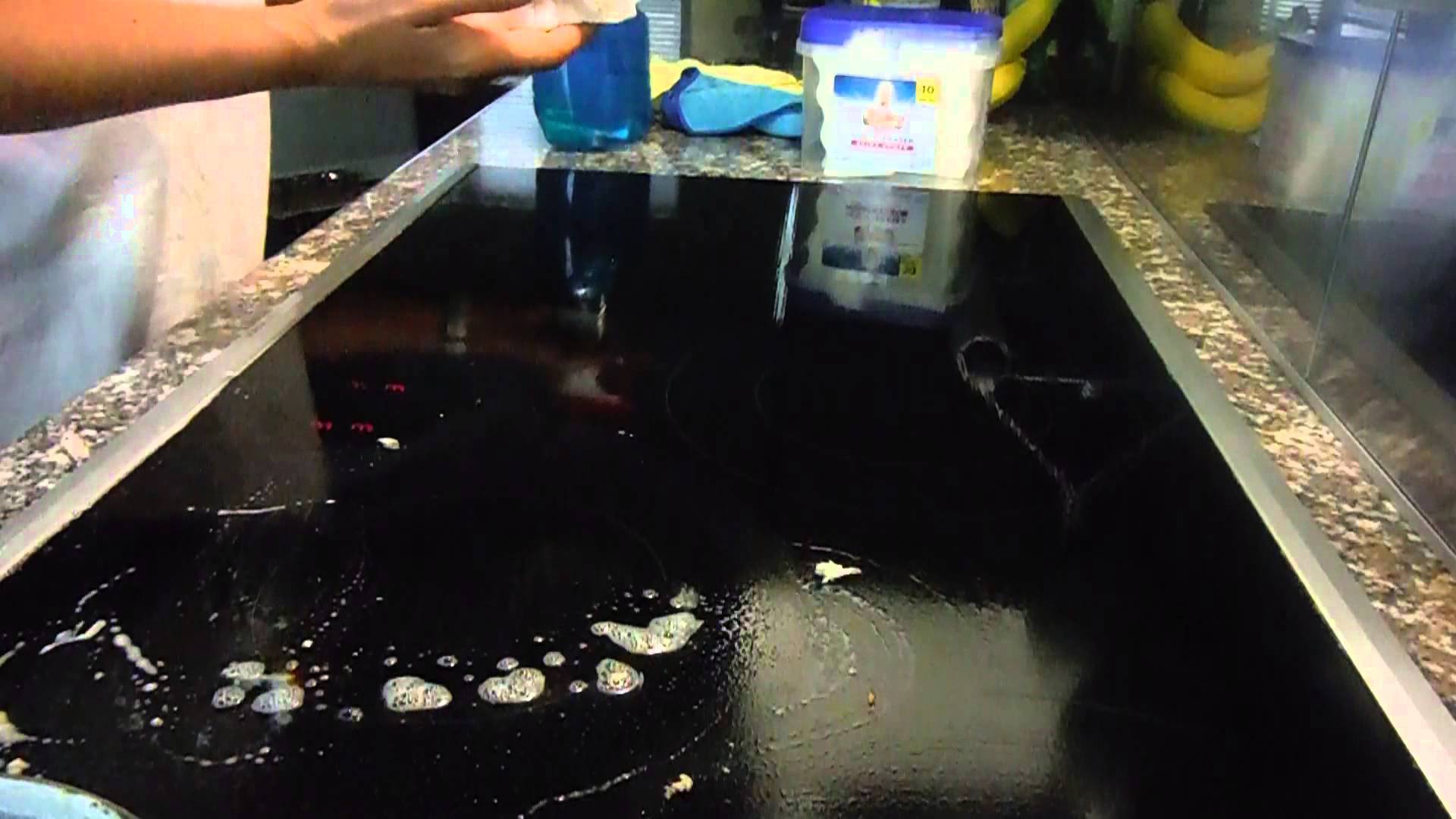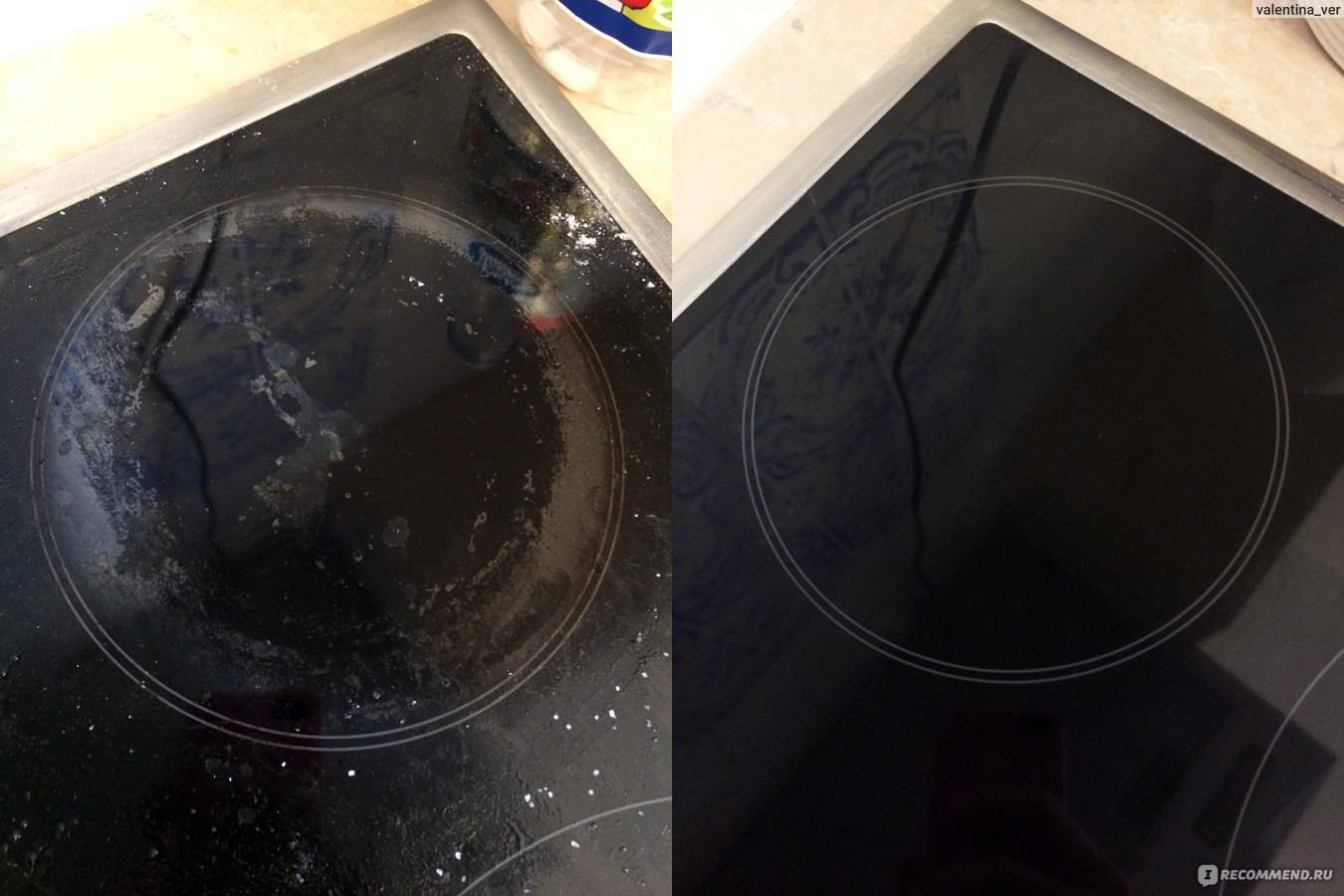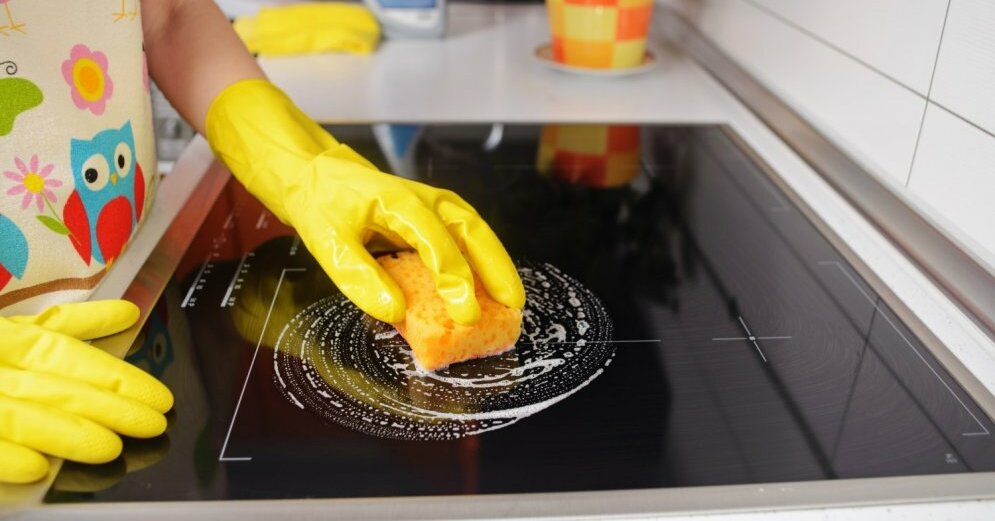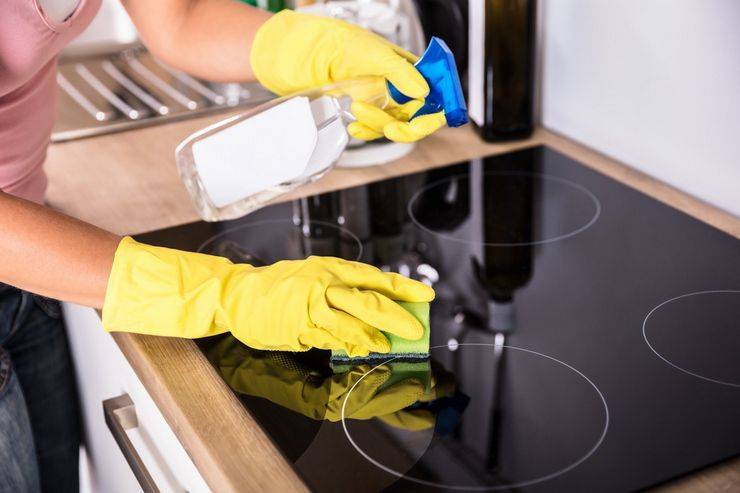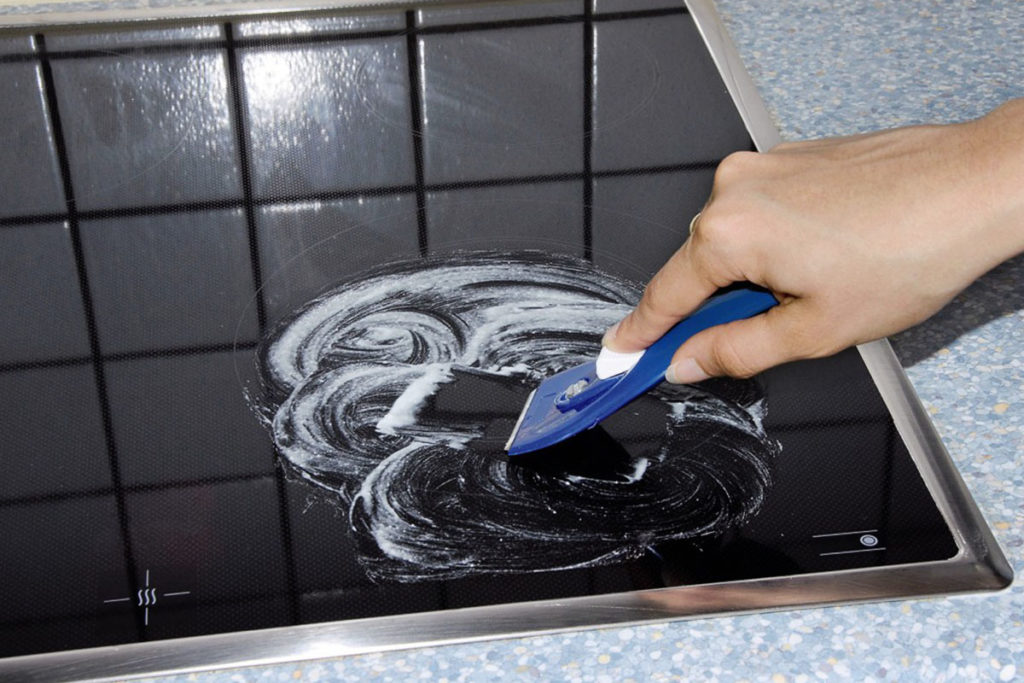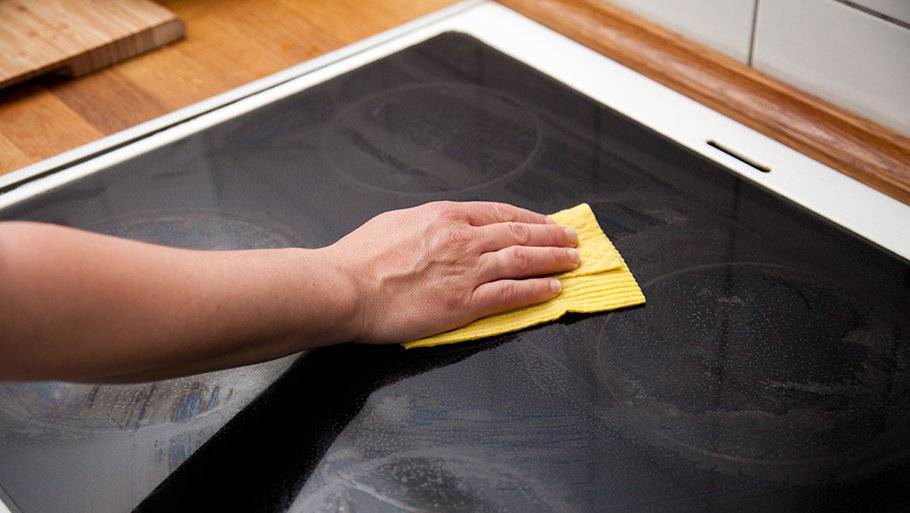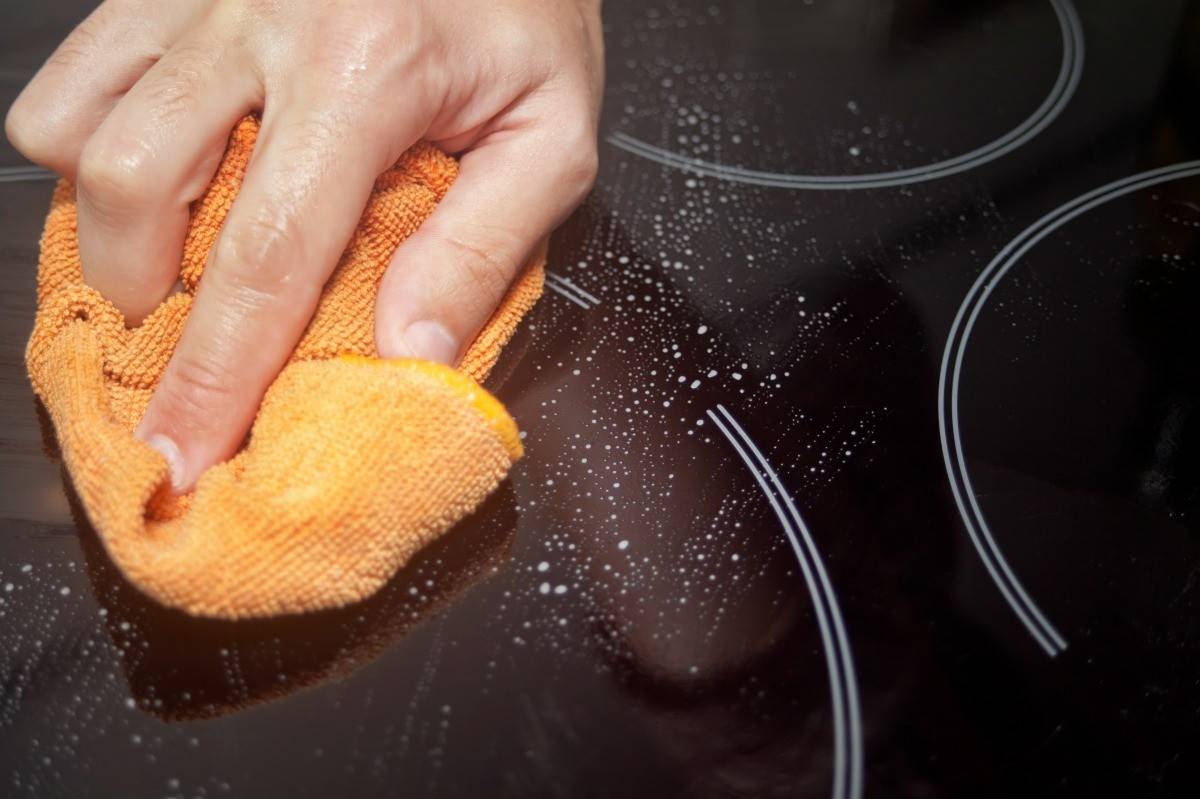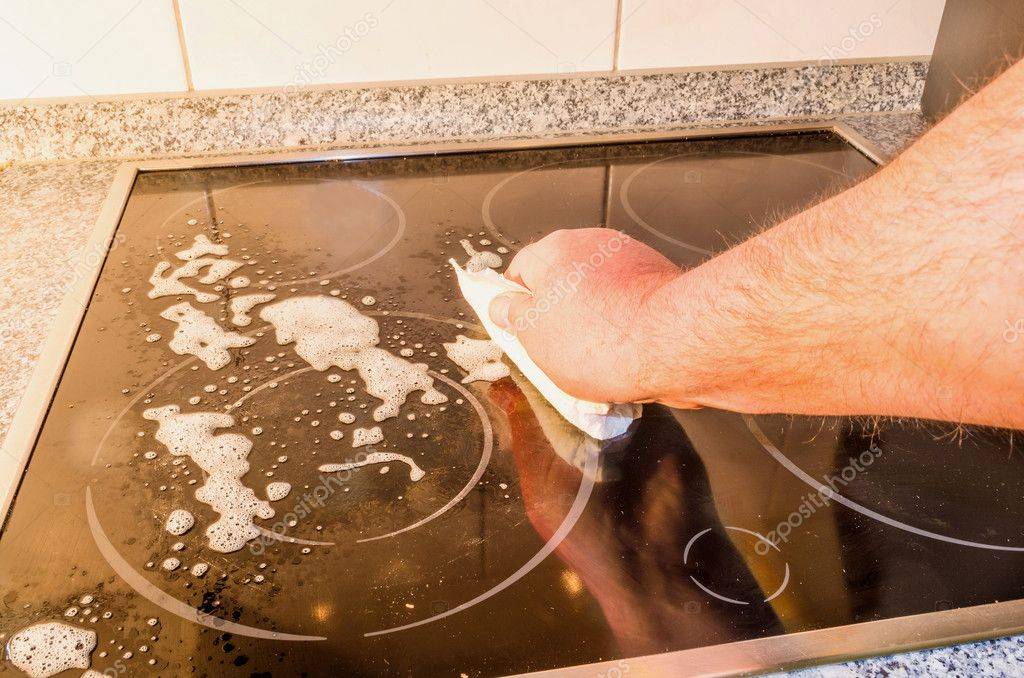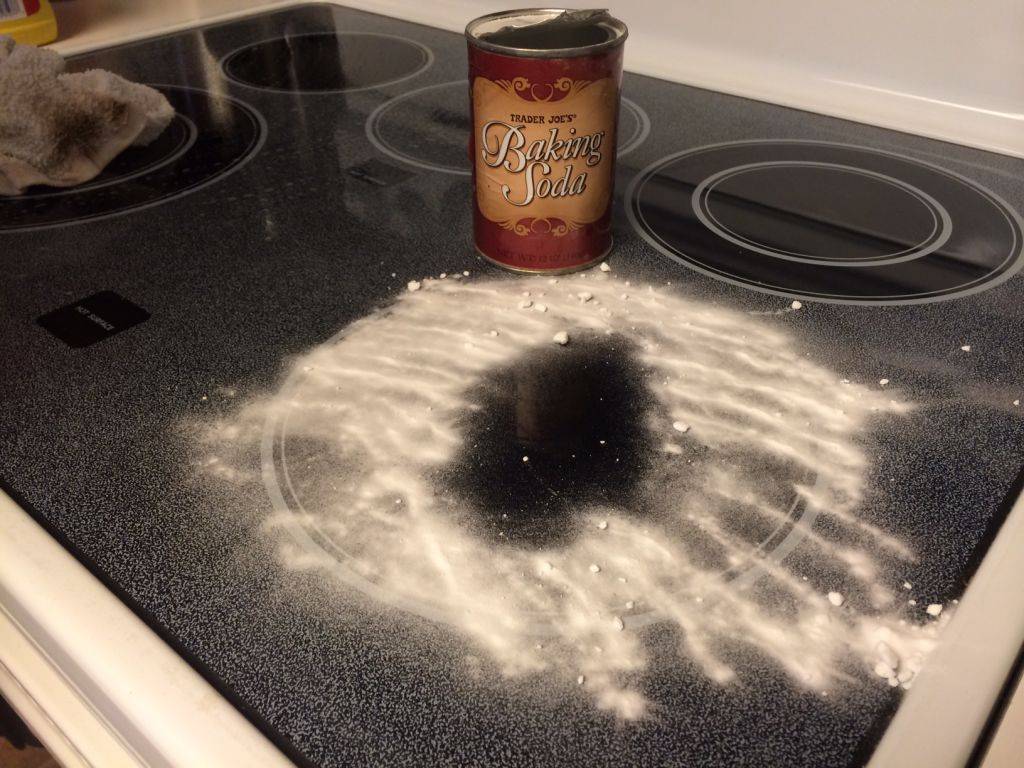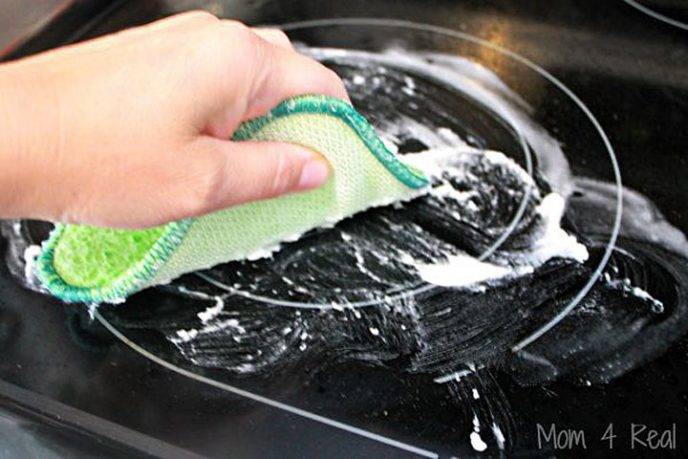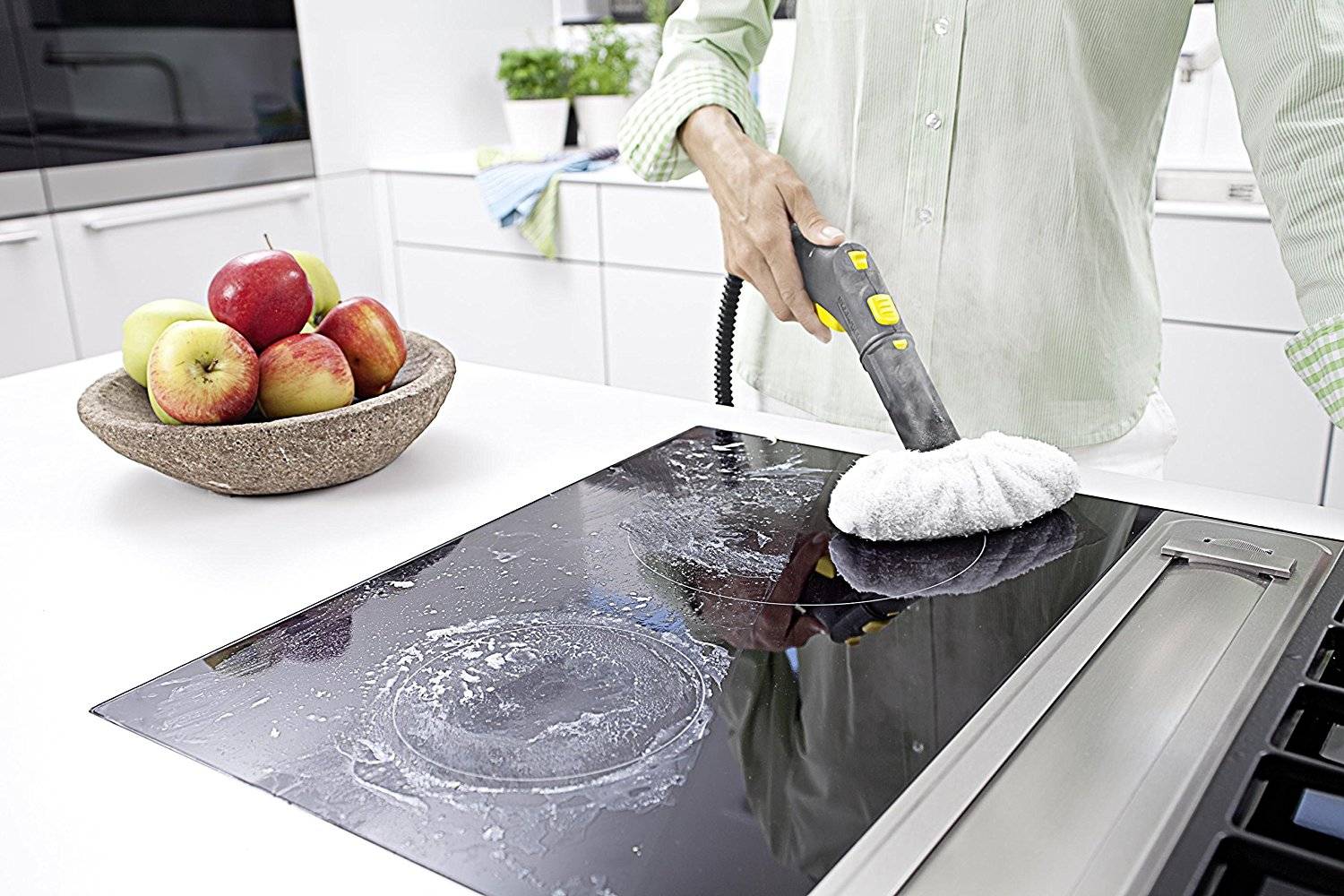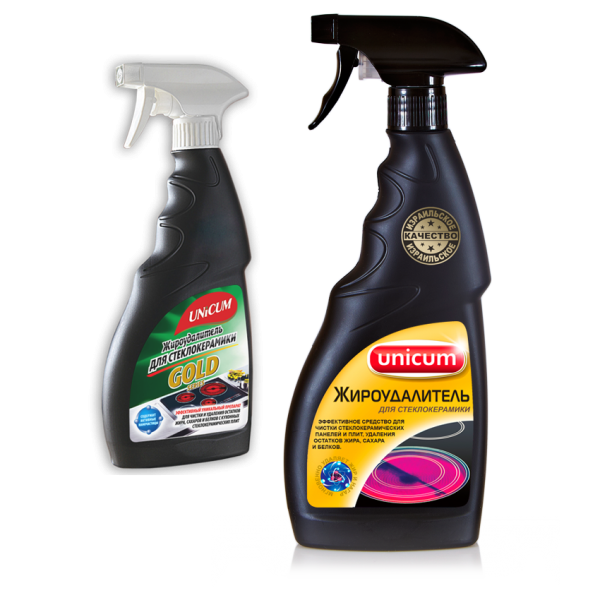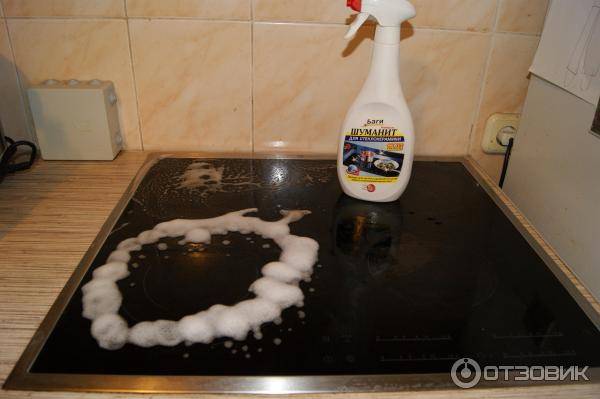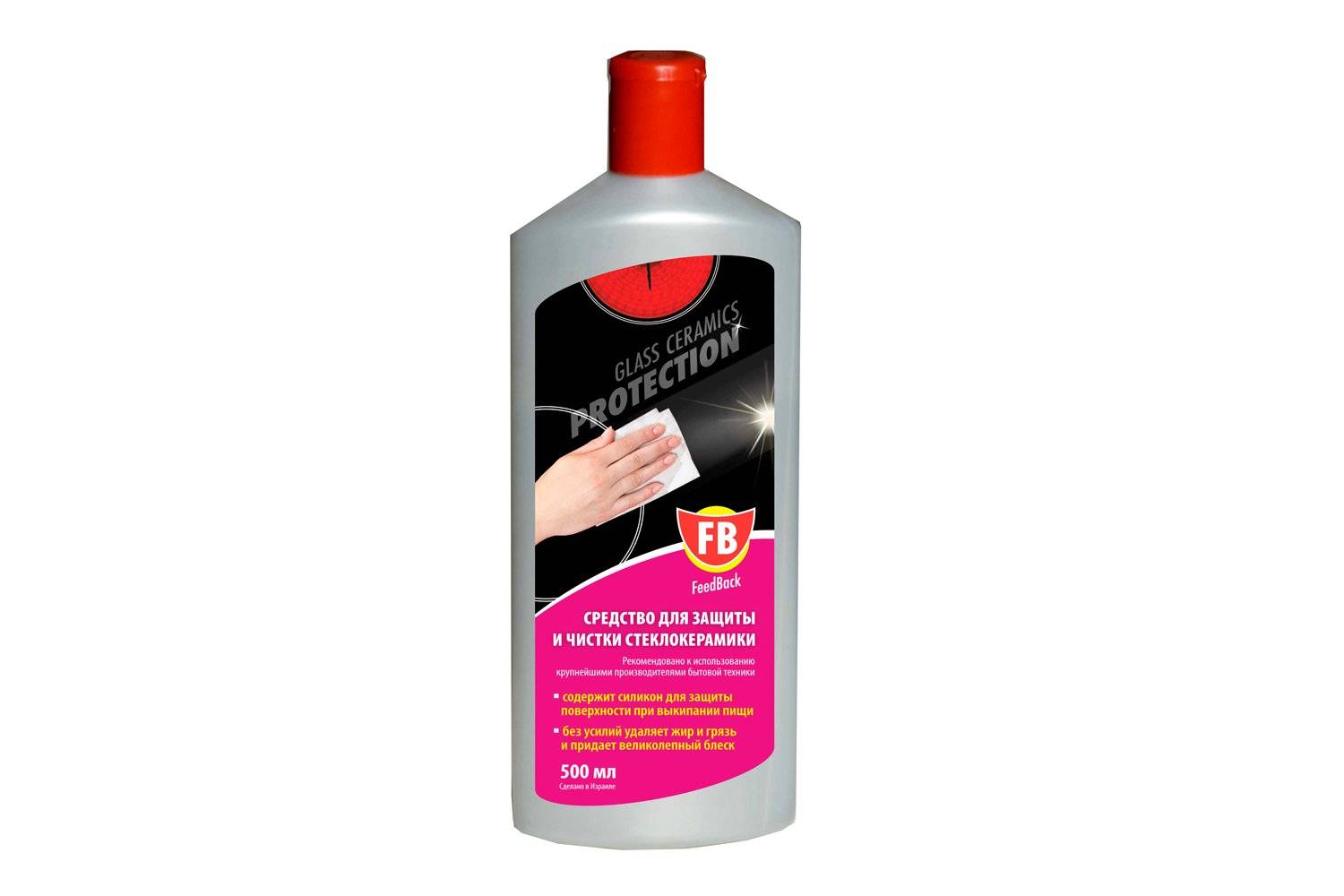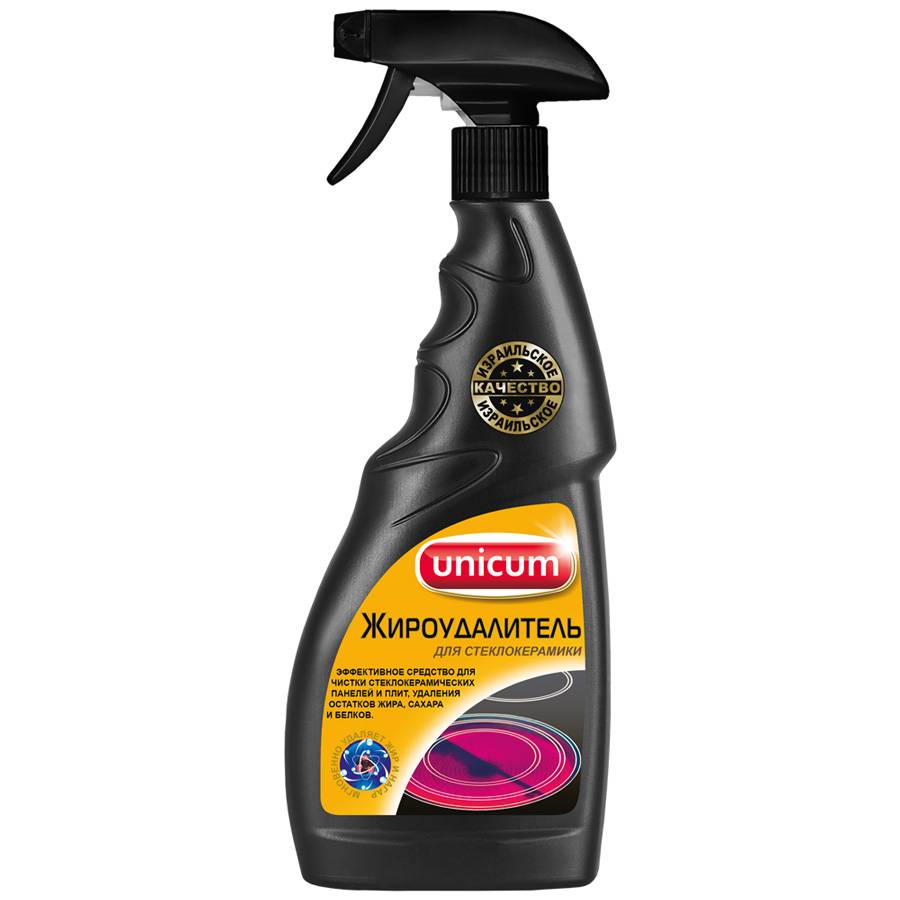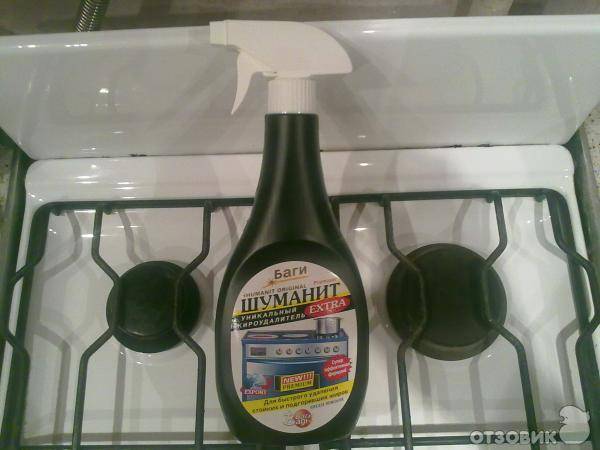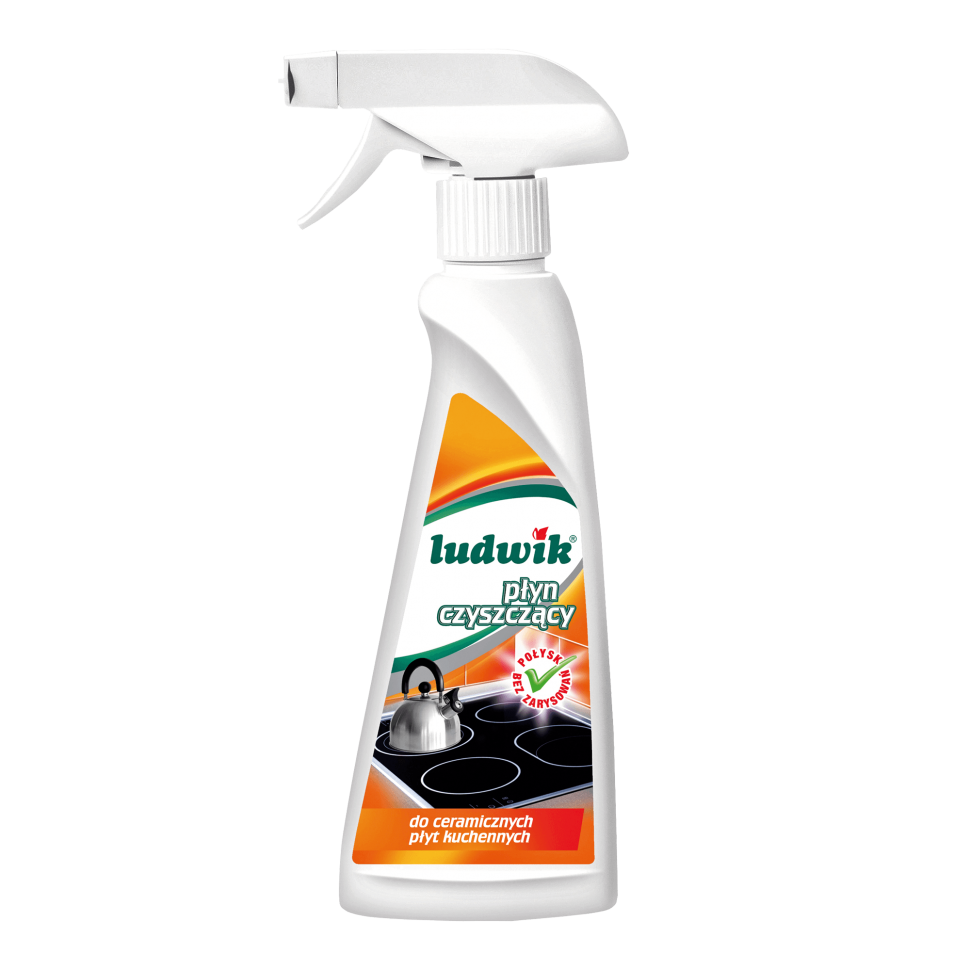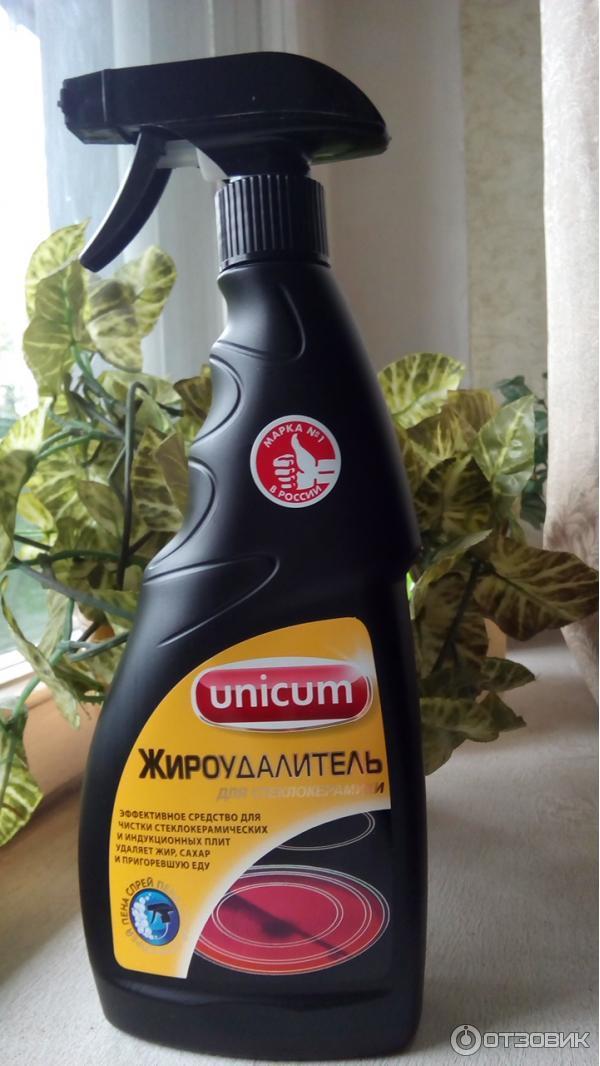How to clean glass ceramics
To put the surface of the stove in order, it is not necessary to purchase expensive accessories and mixtures for its care. This can be done with a range of products found in every kitchen or home medicine cabinet.
Vegetable oil
In this case, this product is more related to protective equipment, since its use is only indirectly related to cleaning the electric stove.

Apply a thin layer of oil to the washed surface with a cloth or sponge. To make the layer thin, the oil must be thoroughly grinded. As a result, a protective film forms on the surface, which will allow you to quickly and without consequences clean the contaminated glass-ceramic plate.
Olive oil to remove stubborn stains
This food product, in addition to the well-known taste, has remarkable cleaning properties that will help get rid of even old carbon deposits:
- Apply oil liberally to a piece of rag or cloth.
- We blot the problem area so that the oil completely covers the stain.
- We leave for 20-30 minutes, after which we try to remove the dirt with a scraper.
- We wash with ordinary dish gel, rinse with clean water and wipe with a soft cloth.
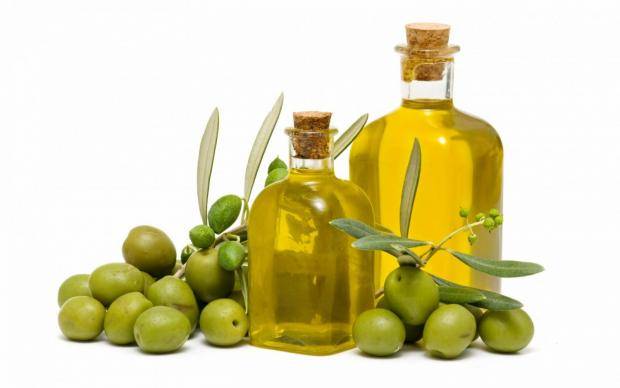
Care products
Many kitchen and bathroom tile cleaners and plumbing cleaners will help wipe away any kind of burnt food. To exclude unpleasant surprises, it is better to first familiarize yourself with the product label in order to make sure of its gentle effect on the glass-ceramic coating.

Lemon juice and baking soda
It is possible to remove old stains with ordinary baking soda due to its caustic alkaline composition and abrasive properties. Soda abrasive is quite specific and has a destructive effect only on dried spots. As for the plane of the glass-ceramic slab, it is absolutely safe for it, since it is too soft to leave even a microscopic trace.
- Add warm water to the soda in such an amount to achieve a pasty consistency.
- The resulting composition is applied to the spots in an amount sufficient for absorption.
- We wait a few minutes, but do not let the paste dry completely.
- Wipe gently with a soft cloth and rinse off the rest of the mixture with water so that no streaks remain.
- If traces remain, repeat the procedure and this time let the solution dry partially.
- Wet the dried spot with lemon juice.
- As a result, a neutralization reaction should occur, which is accompanied by foaming, after which even the most persistent formations will exfoliate.
- The remains of the foamed composition can be washed off with dish gel and wiped dry.

Table vinegar
Acetic acid is an effective antibacterial agent, besides, it can easily remove stains and fatty formations.
- We make a solution of water and vinegar using equal amounts of both liquids.
- Pour the mixture into a container with a spray bottle and spray it evenly onto the plane of the plate.
- We wait 5 minutes and wipe with a clean cloth.
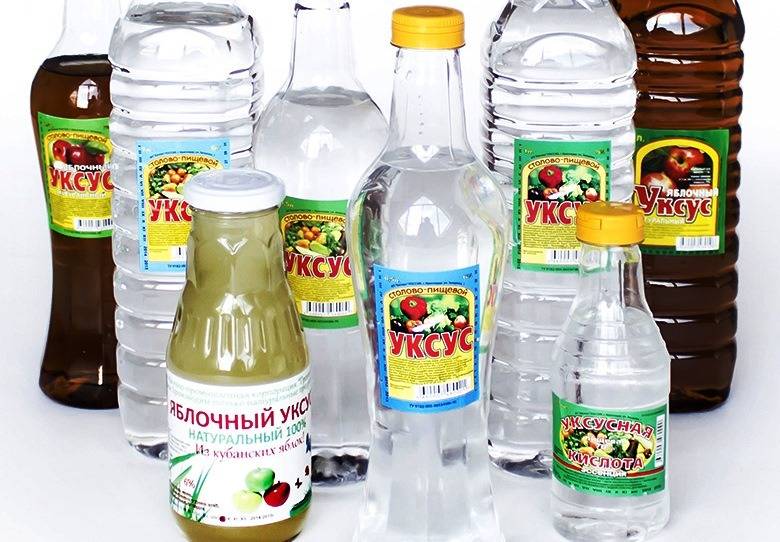
Ammonia
The cleaning properties of alcohols are quite applicable to glass ceramics. You can wash burnt milk, stains left after salty liquids and many other contaminants with ammonia. In addition, the surface after alcohol becomes mirror-shiny.
- We mix water and ammonia in a ratio of 1: 5 (10 g of alcohol per 50 g of water).
- Pour everything into a spray bottle and cover the plane of the plate with the composition, focusing on the burnt areas.
- We wait 10 minutes and then wipe with a soft cloth.
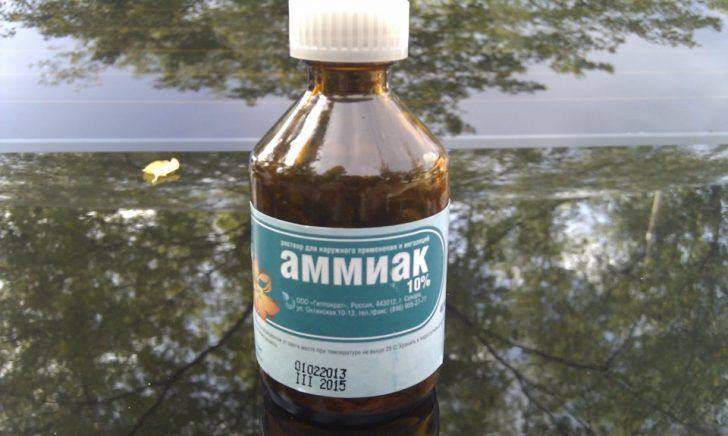
You can also remove burnt-on rags with ammonia. To do this, the problem area must be abundantly covered with the mixture, the preparation of which is described above. Wait 5-10 minutes, then scrape off with a special plastic spoon or metal scraper.
How to clean a glass ceramic hob
 Cleaning the hob
Cleaning the hob
Starting cleaning after cooking, it is worth remembering a few simple rules that should be strictly followed. First, you need to wait until the hob has completely cooled down. This will be indicated by the heat indicator. Then - moisten a damp sponge or microfiber cloth with dishwashing detergent, lather, apply evenly to the surface and, after removing all greasy stains and food debris, rinse thoroughly.
It is important to leave the stove dry and rinse the solution thoroughly without leaving any residue. With insufficient cleaning of the detergent, there is a possibility of the appearance of stains and clouding of the stove during subsequent cooking, because the incompletely removed detergent will boil and heat, and therefore, change its chemical properties and negatively affect the hob
Important! In case of an unsuccessful attempt, it makes sense to enhance the effect of the detergent - leave it on the hob for half an hour, and then rinse it off. Prolonged exposure to detergents will remove all contaminants with high quality
It is necessary to ensure that during cleaning there are no small elements on the surface that can scratch the surface (crumbs, food debris, etc.) or abrasive particles in the composition of the cleaning agent. It is worth forgetting about metal brushes and plastic dishes, which can melt from too high a temperature and stick to the hob. It is better not to abruptly move the frying pan or pan from the hotplate to the hotplate in order to avoid mechanical stress on the glass ceramics.
Additional Information! When using such a stove, it is forbidden to use aluminum cookware, which is absolutely incompatible in its properties with the hob.
Special cases of contamination
Fusible materials such as burnt sugar or plastic should be removed immediately.
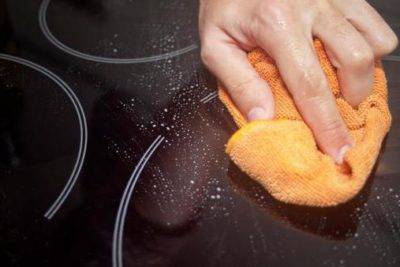
Sugar on a hot glass ceramic hob creates a dangerous situation. Manufacturers warn about the destruction of the high-tech coating: the sugar crystal lattice is similar to the surface structure. For this reason, the sugar will burn holes in the surface.
If, nevertheless, sugar gets on the stove during cooking, it should be removed while still hot or warm, before it has time to solidify. It is necessary to disconnect the device from the mains, remove the melting sugar, rinse the surface with a usual detergent.
Stains resulting from melted plastic should be removed before they have cured. If, nevertheless, the moment is missed, reheat the surface, remove the stain with a cleaning scraper.
If milk burnt, coffee or jam escaped, it is recommended to remove these liquids from the hot stove as soon as possible in order to avoid crystallization. You can use a scraper to remove the stain from the surface. If a rag is used, it should not be cold.
If thick organic compounds come into contact with a hot surface, it is difficult to remove them with a cloth. It is enough to wait until they burn out to the state of coal, then remove the remnants with a metal scraper.
You can take care of the glass-ceramic surface with the means available to every housewife. With proper care, the glass ceramic hob will last for more than a dozen years.
Glass-ceramic coating: features of modern coating
Convenient functional appliances have appeared in the kitchens of domestic housewives relatively recently and are already very popular due to the following advantages:
- fast heating and cooling rate;
- even distribution of heat along the vertical;
- the ability to adjust the degree of heating in the zone of the burner to the size of the dishes standing on it;
- stylish design that blends perfectly with the interior of any kitchen.
The stove is easy to use: the hostess does not have to lift the pot to move it. It is enough to slide the container to the side on a smooth glass-ceramic surface.
How carbon deposits form
No matter how modern the technique is, no matter how carefully it is used, the surface will still get dirty during operation. Traces on the panel leave:
- splashing fat from the pan;
- drops of water flowing down from the dishes;
- salty or sweet liquids.
Where fire is used, scale is always collected. If the glass-ceramic surface is not cleaned in a timely manner, the stove will quickly lose its attractiveness and functionality.
What utensils to use
If the household already has pans and pots made of stainless steel with a flat bottom, then they are suitable for a glass-ceramic stove. But it is advisable to acquire new dishes - traces of the old can remain on the surface (sometimes scratches from the rough bottom).
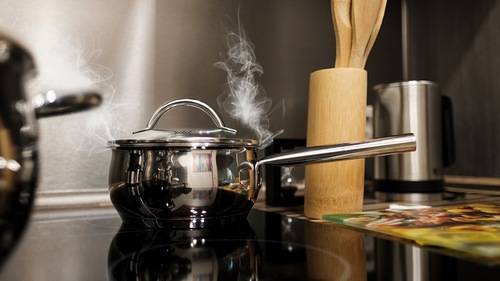
The following requirements are imposed on dishes used on a ceramic plate:
- pots and pans are selected according to the diameter of the burners;
- for better heat transfer, the base of the dishes should not be deformed;
- choose containers only with a smooth bottom in order to exclude damage to the surface;
- the optimal base thickness is 2-6 mm.
Pans and pans with a multilayer bottom are sold especially for glass-ceramic stoves. There are layers of aluminum or copper between the stainless steel sheets.
You can also use enameled dishes, but you should not leave them empty on heated glass ceramics: this leads to deterioration of the coating and its subsequent replacement.
Prohibited cleaning methods and products
In caring for modern stoves, it is important to follow the rules. There are a number of prohibitions that should not be ignored:
- you cannot clean the heated surface - ceramics may crack;
- do not use dishwashing sponges and household rags - they leave ugly stains;
- the coating can not be scraped with scouring pads and metal brushes, as well as with knives;
- ordinary products are also not suitable: they are not effective on glass ceramics and can discolor the coating.
Manufacturers of such kitchen appliances (for example, Electrolux) produce special preparations for the care of stoves that quickly remove dirt of any complexity and cover the panel with a silicone film, protecting the food that has fallen on the surface from sticking.
Care rules
It is important to know how to clean your glass ceramic hob. What detergents to use, which sponges to choose
What can not be washed and when to carry out a global wash.
3> Observance of cleanliness
People hardened by household chores know that the stove is easier to clean if it is kept clean. When small spots hit the surface, they are immediately wiped off, without waiting for new ones to appear. Regular washing will get rid of global cleansing of carbon deposits and grease layers that have accumulated for months.
The right tools and tools
One of the most important moments in stove cleaning. Properly selected cleaning tools will keep the panel intact and free from scratches.
Regularity
Electric, as well as gas, glass-ceramic stove must always be clean. Regular cleaning keeps it in top condition.
Plastic
It is strictly forbidden to put plastic dishes on ceramic. On a hot surface, it will melt and stick. Glass ceramics do not like this.
Integrity of utensils
Taking good care of the hob, there is still a chance to damage it. This occurs when a person uses poor quality dishes. As a rule, these are uneven dishes covered with scratches and dents.

Aluminum
Cookware made of this material is not suitable for glass-ceramic hobs if it is of poor quality. As a rule, the bottom is not covered with a special compound. Because of this, they leave marks on the stove that cannot be removed.
When can you clean
You can proceed to cleaning after the stove has completely cooled down. You can find out the surface temperature using the residual heat sensors that are located on the panel. If you wash it hot, there is a chance that the person will not avoid burns. As a result of temperature differences, the panel may crack.
Care and maintenance tips
The first thing to remember about caring for a glass-ceramic induction electric stove is to regularly clean it from grease and other contaminants. This means that it is better to wash the hob every time you prepare food, so that later you do not rub off old stains with the risk of leaving scratches.
Rare cases of panel damage:
- It happens, it happens that sugar spilled onto a hot electric stove. It must be removed immediately! Turn off the equipment and remove the melted white product with a special scraper. The same should be done if milk is spilled.
- Despite the fact that an induction cooker is a fairly hardy device, it will not withstand local sharp shocks. For example, if you drop a knife on the surface, be prepared to see the cracks stretch.
- Never place cold pans and pots on the glass ceramic hob. The temperature difference is another reason for its deterioration.
General recommendations for daily use are simple:
- Before reheating the burners, make sure that there are no food residues on the stove - they will burn, and instead of cooking, you will have to clean it urgently.
- Wipe the surface with a damp cloth after each use - this will make it easier to clean.
- There must be special cookware for the induction hob. Plastic, copper or aluminum products will stick to the panel, and, most likely, the traces will no longer be cleaned, which means that you will never be able to use it.
It may seem like buying a glass ceramic hob is a bad idea. But if you make it a rule to wipe it every time, there will be no problems. Another tip that might come in handy is just be careful. Try not to spill water or other liquids on the hot stove, but wipe up the spill immediately.
Method 2. How to clean a glass-ceramic hob with soda
We want to warn you right away: all manufacturers prohibit the use of soda for cleaning glass-ceramics because of its abrasive properties (micro-scratches remain on the surface, due to which the gloss is somewhat lost). However, as practice shows, soda does not bring significant harm, and most users use it to wash glass ceramics on a regular basis. If your stove is very dirty and you don't have anything close at hand, you can try this cleaning method.
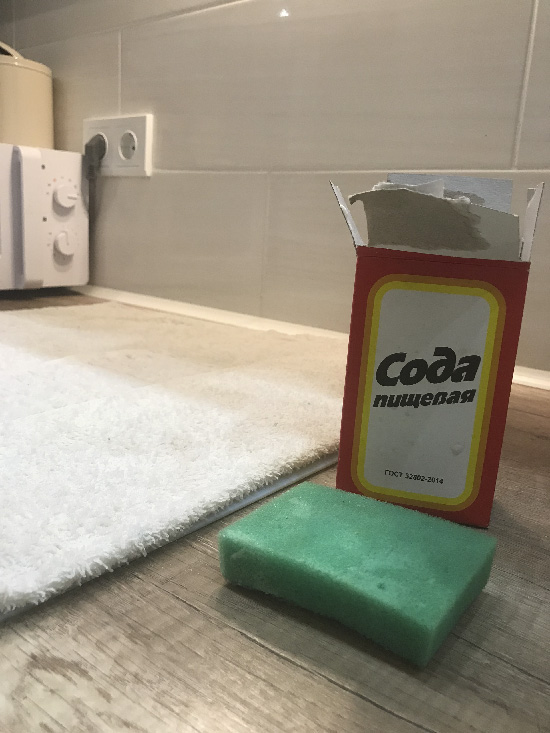
Due to its alkaline properties, it copes well with old carbon deposits, dirt and grease
Instructions:
- Sprinkle baking soda all over the stove.
- Prepare a solution of hot water and dishwashing liquid in a small bowl.
- Soak a towel well in soapy water and completely cover the stove with it as shown in the photo.

- Leave the towel on for 15-30 minutes to loosen any dirt.
- Rub the surface of the stove with the same towel, using the rest of the baking soda as a rubbish against soot and dirt.
- Thoroughly wash and wipe the glass ceramic clean and dry. Use 9% vinegar if desired to remove any baking soda residue faster.
Advice:
- Instead of one large towel, you can use two small ones.
- The towel should be wet enough to dissolve the baking soda and wet the surface, but not so wet that it puddles and drips off the stove.
- This method of cleaning can be used immediately after method number 3 (see below) - this will make cleaning even more efficient.
- Particularly stubborn dirt can be removed with a soda paste (soda + water in a 1: 1 ratio). In this video you can see how to clean a glass ceramic hob with soda paste.
How to care for your ceramic hob
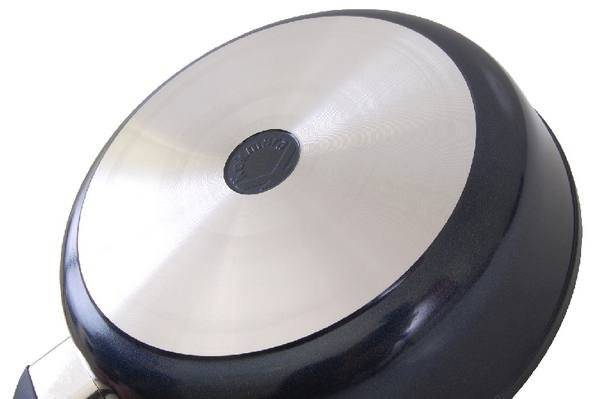 For cooking on the ceramic hob, you should only use pans with a smooth bottom.
For cooking on the ceramic hob, you should only use pans with a smooth bottom.
To keep your stove always clean and sparkling, you need to take proper care of it. On the glossy surface, all the dirt is very clearly visible, which spoil the appearance of the stove and the mood of the hostess. Therefore, the main thing in maintaining a ceramic surface is regularity. It is necessary to wash the stove every day, do not allow the build-up of dirt and grease on the hob.
Proper care of your glass ceramic hob implies compliance with the following rules:
Do not start cooking if there is dirt on the stove. When heated, they will burn and dry so much that it will be quite difficult to remove them later.
Wait until it has cooled down before cleaning the glass-ceramic hob. Otherwise, you risk not only getting burned, but also damaging the surface.
Use soft cloths, rags, sponges, and detergents that do not contain abrasive particles to clean glass ceramics. The best options are creams and cleansing pastes.
Avoid the formation of scratches on the hob, even minor defects can significantly reduce the quality of the hob and spoil its appearance. To avoid this, use pans with a smooth bottom to cook and heat food.
Do not place plastic containers on the hob. If the surface does not have time to cool completely, then you will have to decide how to clean the ceramic plate from the molten plastic.
Remember that strong static loads and point shocks are contraindicated for a glass-ceramic hob - this leads to surface damage.
Therefore, be careful when using the product.
A slab sparkling with cleanliness is the pride of any housewife. With proper use and careful care, it will serve you for a long time and retain an attractive and neat look.
Read more:
- All the tools to help clean the gas stove
- Let's clean the coffee machine from limescale with citric acid
- How to replace dishwasher salt
- Do I need sharpening knives for a meat grinder
- How to clean the iron from burnt fabric at home
Clean induction surface
Not all housewives have the opportunity to monitor the stove every day, as a result, serious efforts have to be made to clean the surface.
 To remove organic contaminants, they will have to be soaked.
To remove organic contaminants, they will have to be soaked.
The cloth is moistened in a solution of detergent and spread over the hob.
After a few minutes, the stain can be quickly removed with a scraper.
Try to use detergents as little as possible, as they leave streaks on the surface.
Attention! The main enemy of induction cookers is sugar. Several stains that have fallen on the touch surface must be immediately removed with a damp sponge and treated with a professional gel.
- towels;
- sponges;
- soft tissues;
- professional cleansers.
Scrapers, which delicately handle dirt, will help to remove fatty formations. Melamine sponges are often used for cleaning. They are practical and quickly get rid of stains of any complexity.
Professional glass ceramic cleaners will not only clean the product, but also create a protective film to prevent scratches and some stains. If there is no special solution at hand, then you can use any non-abrasive gel.
It is not recommended to pour the cleaning agent onto the hob: they only need to moisten a sponge or soft cloth.
A clean and sparkling hob is a decoration for any kitchen.Using improvised household products and professional chemistry, you can easily and quickly get rid of any stains on glass ceramics. Compliance with some of the recommendations will extend the life of household appliances.
Cleaning a ceramic kitchen stove using available tools
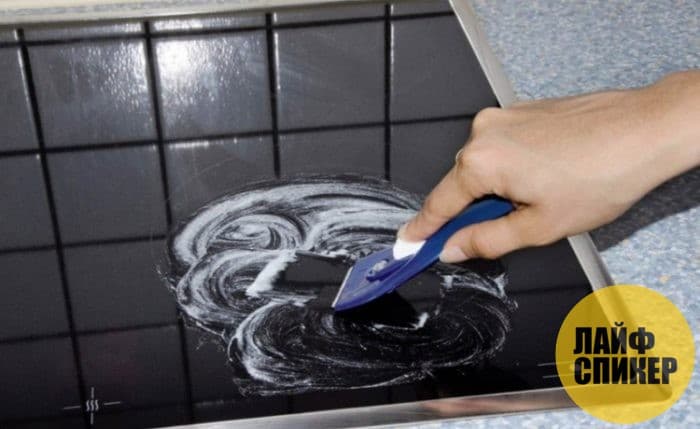
Despite the fact that store shelves sag under all sorts of household chemicals, many people prefer folk methods in caring for kitchen appliances. Their advantages are low cost and hypoallergenicity. Let's see what folk methods are suitable for cleaning glass-ceramic plates.
Lemon juice or citric acid
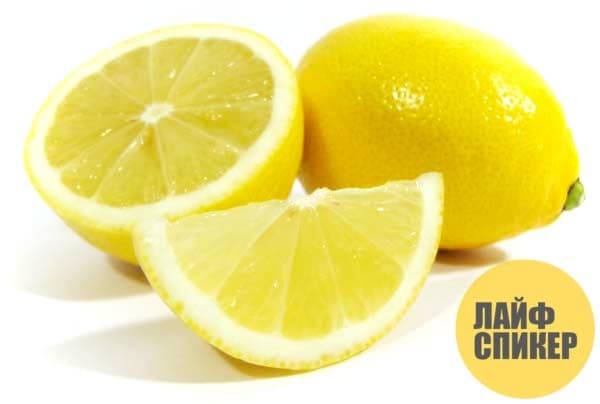
Apply natural lemon juice to the dirt or wipe it thoroughly with water with citric acid dissolved in it, wait 15-20 minutes, and then wash everything with clean water and wipe dry. Citric acid works well for dried grease and burnt dirt.
Soda
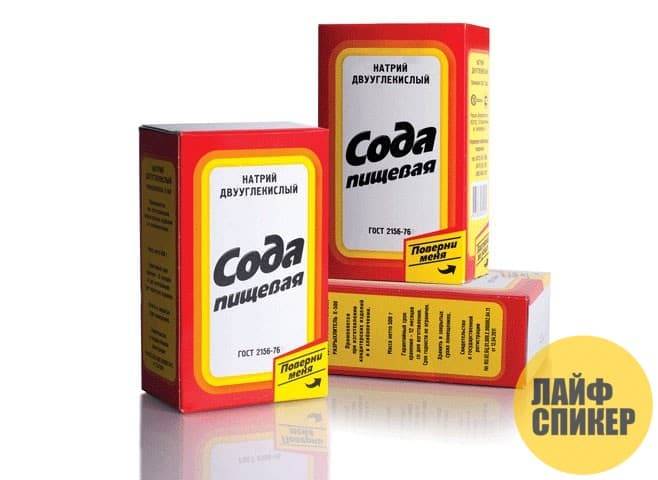
Baking soda, which is probably in the arsenal of every housewife, easily removes grease and dried splashes. If you apply it on a wet sponge and soak it well with water, and then apply it on the dirt and leave it there for 15-20 minutes, the stains will go away, you just have to wipe the surface of the stove dry.
Vinegar
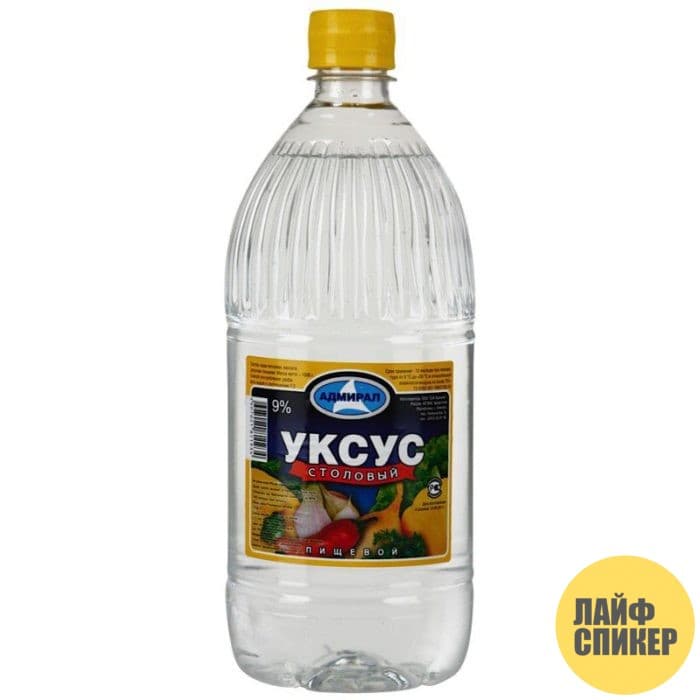
Vinegar works similarly to citric acid. To clean glass ceramics, use a 50% solution of liquid, which should also be applied to problem areas and left for a couple of minutes. However, the disadvantage of such a tool is in its pungent smell, so this method should be used in a room with open windows.
Laundry soap
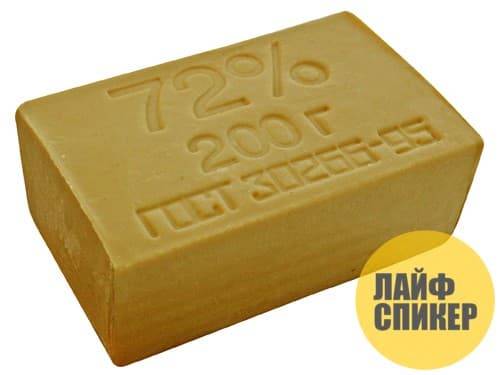
This is a simple and affordable method, which for some reason is undeservedly forgotten. Lather on a soft sponge until it forms a rich lather and transfer it to the dirty surface. Leave it like this for a while, and then just wash it in the usual way and wipe it dry.
Glass ceramic hob scrapers

These are special devices that can be plastic or equipped with metal blades. The peculiarity of such blades is that they do not damage the surface, as they were specially developed for it. Scrapers are used to remove stubborn burnt dirt, but first, a cleaning cream or gel is applied to it and left for 15 minutes to soak the stains.
Old stains and carbon deposits
Carbon deposits are more difficult to remove than conventional dirt. Having the skills on how to effectively clean the ceramic stove from adhered carbon deposits, it will not be difficult to cope with the problem.
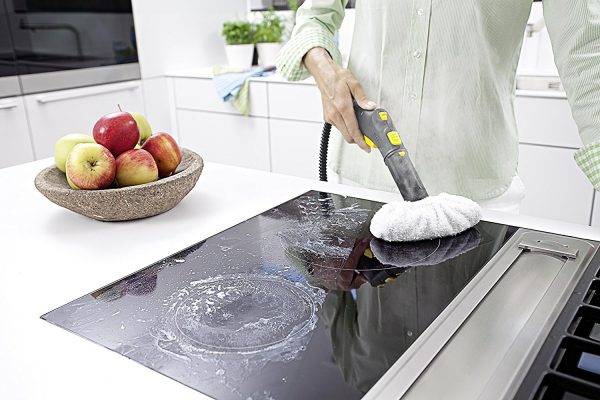
Having the skills on how to effectively clean the ceramic stove from adhered carbon deposits, it will not be difficult to cope with the problem.
To do this, apply a special gel to dissolve fat on the surface previously washed with water. Soda gruel is also suitable. After 30 minutes, remove from the contaminated area with a soft material.
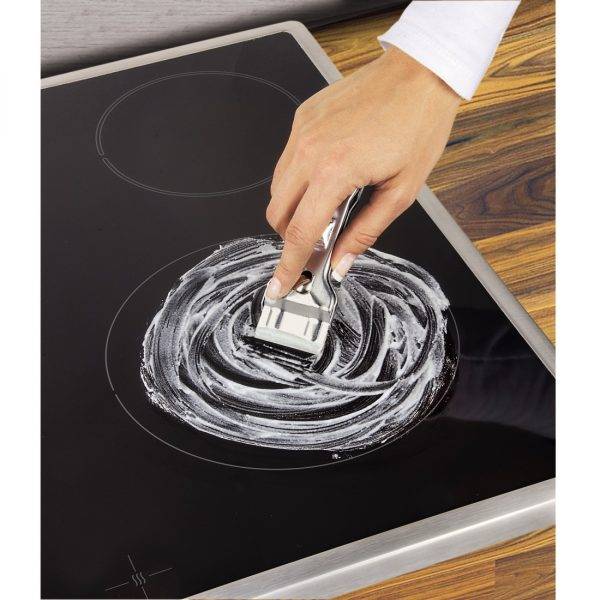
Soda gruel is also suitable.
Stubborn stains are ideally cleaned with a solution of water (250 ml) and ammonia (50 ml). The product is left on the contaminated area for 10 minutes, then wiped off thoroughly with a dry cloth.
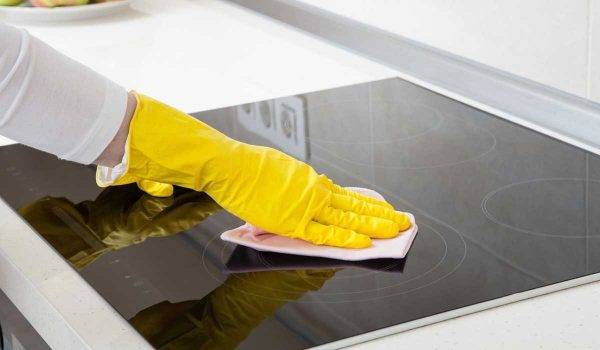
The product is left on the contaminated area for 10 minutes, then wiped off thoroughly with a dry cloth.
Burnt milk stains
There is an effective way to quickly clean burnt dairy products from a glass ceramic hob. Olive oil applied to cheesecloth, cotton pad or sponge is ideal for removal. The compress is placed in for 30 minutes, after which the stain is removed with a sponge or metal scraper. The oil softens the plaque and is easier to rub off.
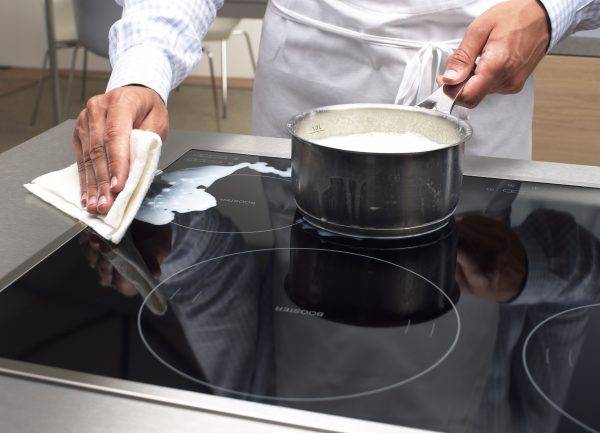
There is an effective way to quickly clean burnt dairy products from a glass ceramic hob.
Heavy pollution
The melamine sponge does an excellent job of removing stubborn stains without the addition of chemicals. All that is needed is to wet with water and wipe the surface.
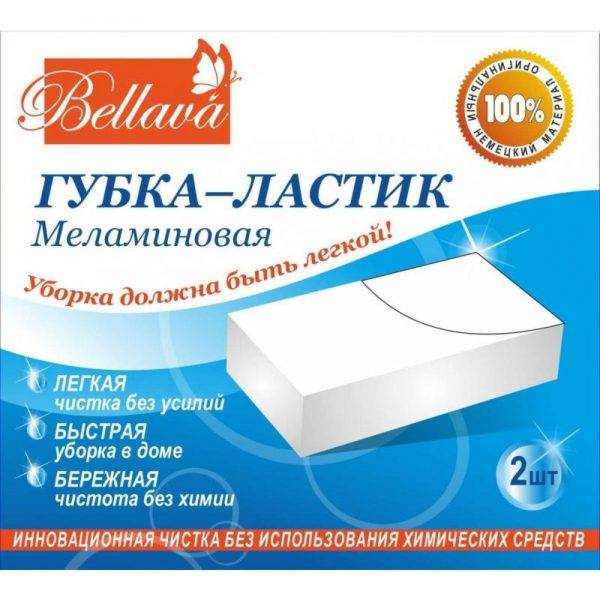
The melamine sponge does an excellent job of removing stubborn stains without the addition of chemicals.
Ordinary table vinegar will also help remove contamination. To prepare the cleaning agent, water and vinegar are mixed in equal proportions, poured into a spray bottle and sprayed onto the surface. After a few minutes, the solution is wiped off with a dry cloth.
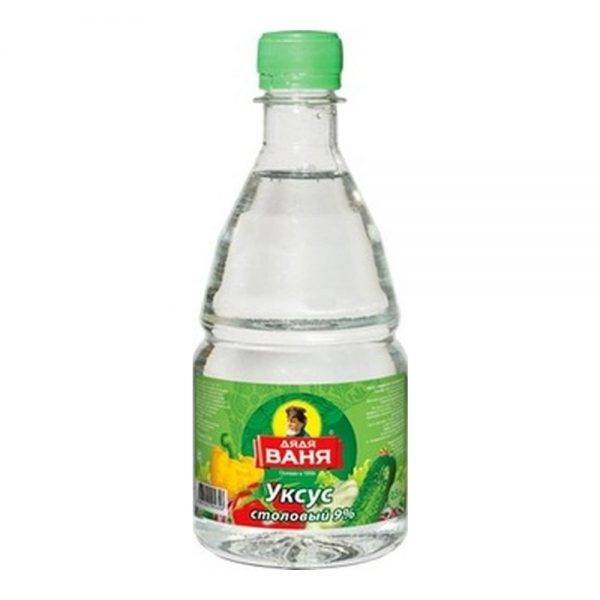
Ordinary table vinegar will also help remove contamination.
Cleaning small parts
In addition to the hob, the stove has small parts in the form of handles. It is much easier to clean the handles if they are detachable. A soap or vinegar solution will help get rid of dirt.

It is much easier to clean the handles if they are detachable
To obtain a soap solution, take 50 g of soap and 100 ml of hot water. We place the handles for 30 minutes, then remove the contamination. The vinegar solution is prepared in the proportions: 2 tbsp. l. vinegar and 1 liter of water. We boil the handles in the prepared liquid for 5-7 minutes.
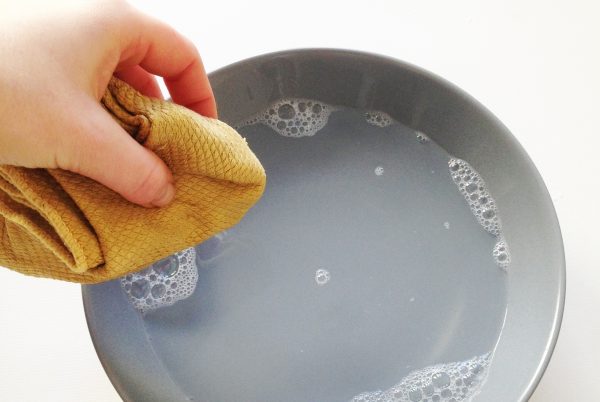
To obtain a soap solution, take 50 g of soap and 100 ml of hot water.
If the handles are not removable, cotton pads, a toothbrush or a toothpick, previously soaked in soda or ammonia, will come to the rescue.
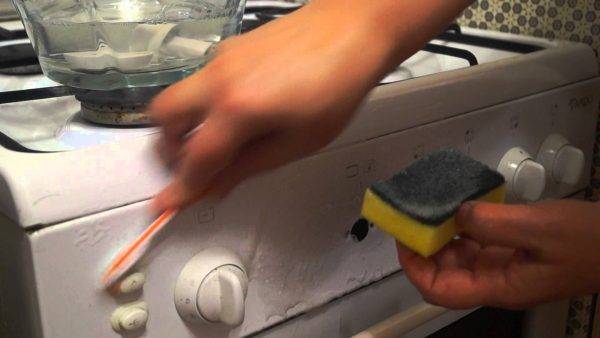
If the handles are not removable, cotton pads, a toothbrush or a toothpick will come to the rescue.
If just dripping grease can be removed using a detergent and a napkin, then how can you wash old dirt?
Olive oil
Old deposits can be easily removed with olive oil. Just drip a little olive oil, let it sit for 15-20 minutes. After that, the carbon will come off much more easily, and you can clean it off with a sponge.
Soda + lemon juice
You can clean the glass-ceramic hob from carbon deposits with lemon juice and baking soda. Take 1 tbsp. l. soda and dilute it with water so that you get a gruel. Apply this gruel to the surface and rub it lightly. After 10 minutes, you can remove the mixture with a cloth - the surface will become absolutely clean. But make sure that the soda does not completely dry out, otherwise you will have to soak the powder.
You do not need to remove the soda completely, but leave a little and pour lemon juice on top. A reaction will begin, which will dissolve all residual dirt. This mixture acts as a powerful detergent.
Vinegar
You can clean glass ceramics from carbon deposits with ordinary vinegar. The surface of the electrical panels is scrubbed with a solution made from equal parts vinegar and water. The solution is poured into a spray bottle and sprayed onto the panel. Vinegar perfectly cleans and even disinfects. You just have to wipe the surface with a damp cloth and wipe dry.
Detergent
Some detergents that are used for washing dishes or the refrigerator can also be used to clean the hob. But you should carefully apply such means so that they do not destroy the glass ceramics. Dish gel is best suited for these purposes.
Ammonia
An excellent remedy for cleaning the hob is ammonia. Ammonium is able to cope with even the most chronic contamination. In addition, the ammonia will add shine to the panel.
Take 250 ml of water and pour it into a spray bottle. Pour in 50 ml of ammonia. Mix the solution well and get down to business. Spray the product onto the glass ceramics and leave for 10 minutes. Then wipe the stove with a cloth and wipe dry.
Vegetable oil
After washing, it is better to grease the panel with vegetable oil, which will create a thin protective film on the glass. Simply wipe the surface with a fiber cloth soaked in sunflower oil. Thanks to the protective film, all splashing grease can be easily removed.
Take care of your glass-ceramic hob like the apple of your eye. Do not be lazy to immediately remove dirt from the surface, even if you are very tired in the kitchen. If you clean the stove in a timely manner and avoid serious contamination, then it will serve you for many years and will look like new.
More news in the Telegram channel "zakon.kz". Subscribe!


